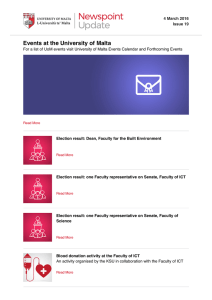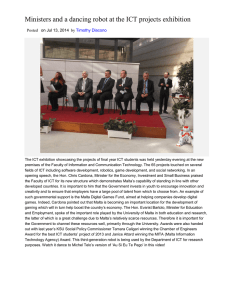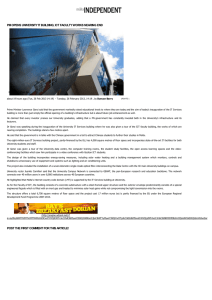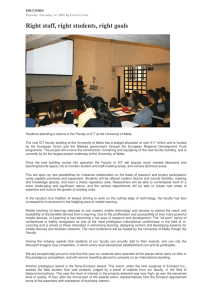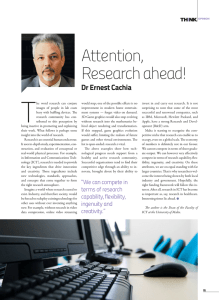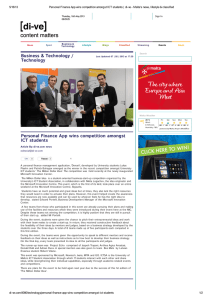Graduation Ceremony 3 Academic Oration Wednesday 20 November 2013 at 1630hrs
advertisement
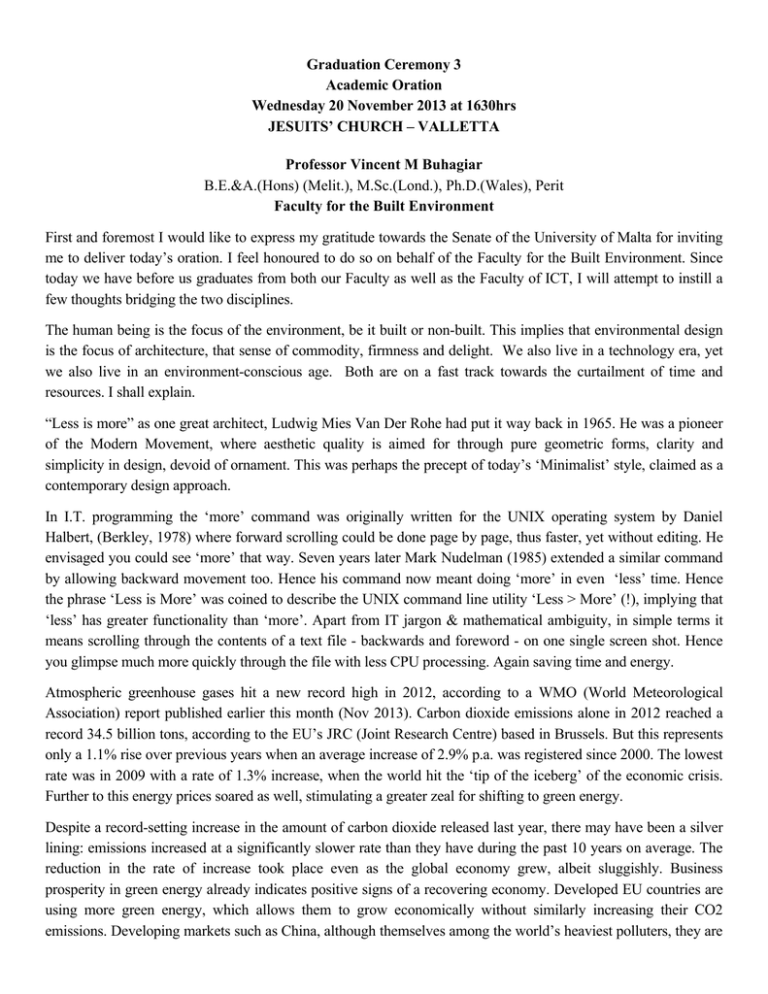
Graduation Ceremony 3 Academic Oration Wednesday 20 November 2013 at 1630hrs JESUITS’ CHURCH – VALLETTA Professor Vincent M Buhagiar B.E.&A.(Hons) (Melit.), M.Sc.(Lond.), Ph.D.(Wales), Perit Faculty for the Built Environment First and foremost I would like to express my gratitude towards the Senate of the University of Malta for inviting me to deliver today’s oration. I feel honoured to do so on behalf of the Faculty for the Built Environment. Since today we have before us graduates from both our Faculty as well as the Faculty of ICT, I will attempt to instill a few thoughts bridging the two disciplines. The human being is the focus of the environment, be it built or non-built. This implies that environmental design is the focus of architecture, that sense of commodity, firmness and delight. We also live in a technology era, yet we also live in an environment-conscious age. Both are on a fast track towards the curtailment of time and resources. I shall explain. “Less is more” as one great architect, Ludwig Mies Van Der Rohe had put it way back in 1965. He was a pioneer of the Modern Movement, where aesthetic quality is aimed for through pure geometric forms, clarity and simplicity in design, devoid of ornament. This was perhaps the precept of today’s ‘Minimalist’ style, claimed as a contemporary design approach. In I.T. programming the ‘more’ command was originally written for the UNIX operating system by Daniel Halbert, (Berkley, 1978) where forward scrolling could be done page by page, thus faster, yet without editing. He envisaged you could see ‘more’ that way. Seven years later Mark Nudelman (1985) extended a similar command by allowing backward movement too. Hence his command now meant doing ‘more’ in even ‘less’ time. Hence the phrase ‘Less is More’ was coined to describe the UNIX command line utility ‘Less > More’ (!), implying that ‘less’ has greater functionality than ‘more’. Apart from IT jargon & mathematical ambiguity, in simple terms it means scrolling through the contents of a text file - backwards and foreword - on one single screen shot. Hence you glimpse much more quickly through the file with less CPU processing. Again saving time and energy. Atmospheric greenhouse gases hit a new record high in 2012, according to a WMO (World Meteorological Association) report published earlier this month (Nov 2013). Carbon dioxide emissions alone in 2012 reached a record 34.5 billion tons, according to the EU’s JRC (Joint Research Centre) based in Brussels. But this represents only a 1.1% rise over previous years when an average increase of 2.9% p.a. was registered since 2000. The lowest rate was in 2009 with a rate of 1.3% increase, when the world hit the ‘tip of the iceberg’ of the economic crisis. Further to this energy prices soared as well, stimulating a greater zeal for shifting to green energy. Despite a record-setting increase in the amount of carbon dioxide released last year, there may have been a silver lining: emissions increased at a significantly slower rate than they have during the past 10 years on average. The reduction in the rate of increase took place even as the global economy grew, albeit sluggishly. Business prosperity in green energy already indicates positive signs of a recovering economy. Developed EU countries are using more green energy, which allows them to grow economically without similarly increasing their CO2 emissions. Developing markets such as China, although themselves among the world’s heaviest polluters, they are still eying green energy emerging markets for competitive influx. One such case is the penetration into the EU with renewable energy technology. Hence the economic crisis, although promoting less spending and lower consumption, has actually stimulated more growth in green energy. Hence ‘less is more’ yet again. In the construction industry in view of global warming and a greater energy consciousness, we are made more aware of the depletion of resources. We no longer talk or focus solely on energy efficiency, but moreover resource efficiency. In Malta, take our local limestone resource; in spite of the shift from soft globigerina building blocks to hardcore aggregate, admittedly a national finite resource, it is still being depleted at a fast rate. Hollow core blocks have replaced double skin soft stone blocks, with a view towards reducing construction time and labour costs as well as gaining more indoor planning space. This shift in building technology has seen an increase in energy demand and new acoustic problems arising from slender partition walls and floors, as we have now moved from terraced houses to flats – albeit with smaller spaces to heat or cool. Owners and tenants are waking up to tangible problems associated with energy wastage through larger glazed openings and single skin HCB (hollow core blocks). Such plain walls have prompted the complete omission of ornament from facades as soft globigerina has practically vanished. This perhaps leads architects to design buildings in the ever-contemporary international style, better known as the Modern Movement. “When the wall departs, the column becomes”, as Louis Kahn (1964) once predicted, so it was: Building technology has now moved away from the load-bearing external skin walls solely built in masonry to structural columns on a grid. Materials and technology now combine in novel ways in the form of structural glass façades with extensive curtain walling deploying the latest interactive glass technology. These bring with them options for greater control of daylight, glare and internal heat gains with the use of sensors feeding into a BMS (building management system) that collects and relays data through a central computer controlling environmental parameters such as daylighting, air conditioning and ventilation rates, depending on occupancy and use. Hence we have achieved greater flexibility in planning, more comfort with less resources. More technology implies less human dependency. Again ‘less is more’. Architectural expression has today taken a new meaning. The rationale behind an aesthetic appraisal of a new building is no longer the selective compartmentation of the design into known styles of architecture. It has become more a case of visually combing the façade to identify any environmental feature that would enhance its energy performance, rather than trying to identify the architectural style to which it conforms. Be it a shading device, a glazed setback or a conspicuous wind tower, environmental design has taken a new meaning in architecture, almost a style of its own – albeit still seen as a coherent unity disciplined with clean geometrical shapes and lines of symmetry, as nature dictates. The aesthetic appeal of a new building is therefore no longer the screening for its architectural style and ornament, but its environmental features. Major companies, (banks, insurance, franchises) often use these to make a bold statement about their corporate image for the environment – even if just as an alter ego, an avatar. Globalisation has taken Malta by storm. As we face greater challenges of information and influx of ideas, we have turned this around into an opportunity. Over the last decade among academics the principal directive was to disseminate the idea of the ‘internationalization of the University of Malta’. We are now already witnessing the success of this with international students among us. Today the main thrust is diversification of courses and study units, as well as a greater inclusion policy to students of all ages, as part of their development. When I was a young boy, one of my treasured collections was a silkworm collection, kept in a shoebox. I used to gradually witness the silkworm spin its own silk, gently enclosing itself in its own cocoon, letting nature take its toll. Silently I knew it would evolve over three weeks, into a compact silk-white butterfly. I used prod the lid gently, to peep in the shoebox, to see whether the butterfly has evolved and come out, ready to spread its wings, ready to be set free. Today this reminds me so much of our Faculty. Since 2009, following a restructuring exercise, spearheaded by the Dean, we are now gradually witnessing the cocoon evolving, changing from the undergraduate BE&A 5-year degree into the 3-year BSc in Built Environment Studies and a 2-year professional Masters. This is in line the Bologna Convention and with new developments and demands of the evolving profession of the Perit. Novel areas are spun around such needs, with a broad variety of Masters being offered, ranging from Sustainable Infrastructure to Environmental Design, and from Spatial Planning to Heritage Management. All these are underpinned by the motive ‘Think Globally, Act Locally’, where we empower our young graduands with a wider choice of specialisation, under the broad umbrella of sustainability. Certainly the shorter span of the emergent silk butterfly’s wings will spread to cover more in the built environment. Once again ‘Less is More’ in this context. To cast all this into concrete action, not only at Faculty level, but on University Campus, blueprint plans have already been rolled out for a new Environment Building. This will house the Faculty for the Built Environment, the Faculty of Education, the Institute for Earth Sciences and Institute for Sustainable Development – a truly multi-facet building, embracing sustainable development in the widest possible sense. It will also act as a forum for debates and further interaction of inter-related disciplines, all happening under one roof – again getting more in less space. But that is only the physical space. What about the human dimension? Students now have the facility to choose a more diversified post-graduate course, not necessarily in line with their undergraduate degree. They will now be able to ‘mix-‘n’match’ study units from different disciplines on the same palette, related to their intended speciality or job description. This broadens further their body of knowledge beyond the niche boundaries of their first degree. It further promotes inter-disciplinarily with pronounced flexibility at the workplace – very much in tune with job market demands. Therefore the student becomes more versatile in more subjects and learns much more in less time. Overseas students are already interested in such prospects that further promote the internationalization of the University of Malta. After all isn’t this how we are also marketing ourselves globally, as academics? All this is closely modeled on the Open University learning system. Drawing a parallel with ICT, ‘Less is More’ applies equally here. The Faculty of ICT is also offering more courses in a wider variety of options, as fast track technology changes are taking place under our very eyes. All this is already accommodated in a new building on Campus. Emerging technologies are all about empowerment and mobility. As we witness the persistent move of apps from desktop to laptop, laptop to tablet and tablet to mobile phone, we become more versatile and flexible as to where we work, with almost seamless boundaries between work and leisure. But isn’t this about putting in more in less space on such gadgets? – same as our modern homes and offices – all in synch. Likewise we can today practically all work from home. With the onset of teleworking, video conferencing and VOIP (such as Skype and Facetime), we can actually work and communicate from virtually anywhere, with nominal commuting. Information technology has pushed the boundaries of a working environment beyond the office walls. ICT has reduced travel, with less pollution, giving us more time at our disposal. Empowerment has seen greater trust by employers in their employees, to work from home basing performance on output deliverables. So where is the boundary between work and home? – or is there any? So again ‘less means more’: less travelling implies less pollution and more working time, more output in less time. With the popularization of the automobile in the 1950s that brought about the introduction of the garage as part of the house; then so did the TV set bring about the TV room in planning a home. Today when designing apartments we are obliged to plan for a ‘study’ to accommodate a quiet workstation, a niche, away from the noisy open plan living room. The living room has taken a new dimension today too; it houses a full-surround system to complement the larger flat screen TV, possibly also connected to a PC for online live streaming or ‘interactive TV’. So yes, we are certainly getting more into less space as we see technology well embedded within our homes. Our new lifestyle is also changing in tandem to all this. However this cannot be said of energy demand: today, almost by some default prompt, we work in air conditioned offices, we commute in air conditioned cars (and now buses) and therefore expect nothing less than air conditioned homes. All this has imposed greater energy demands per square metre for the space we inhabit. We have the duty to design compact homes for smaller families, thus deploying less resources, land, materials and energy. All this augurs well for the 21st century, as a smart home with sustainable living standards. This means less demand on our finite resources, with more use of space to accommodate a healthy and quality lifestyle. Less wastage, wiser consumption is the future. Finally, a word to our young fresh graduates in Architecture and ICT: As professionals you have the inviolable duty to educate your clients to conserve consumption of resources – land, materials, energy and time – for conservation is but the first step towards efficiency. So let’s click on “synch all” as we realize that ‘Less is Future’. Wishing you all the very best in your career and life pursuits. Thank you.
